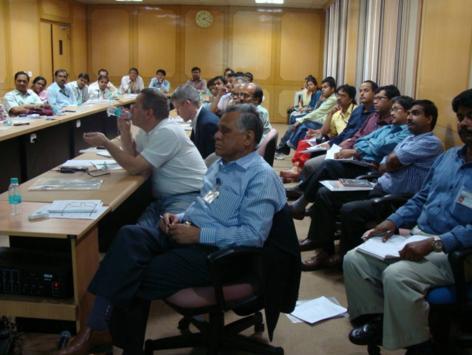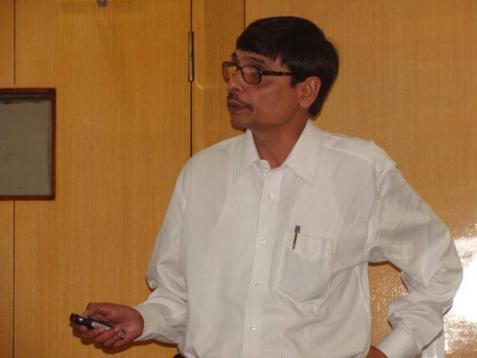

During the first week of March, a team from TRIUMF visited Kolkata, India, to participate in the 2011 VECC/TRIUMF collaboration meeting as part of the ongoing partnership between the two laboratories. The team included Bob Laxdal, Nigel Lockyer, Lia Merminga, Tim Meyer, and Amiya Mitra. Dr. Alok Chakrabarti hosted the event at VECC.
The collaboration meeting lasted two days with a good number of presentations and discussions by both TRIUMF and VECC attendees. A good number (more than 20) of VECC scientists joined the meeting. Topics included manufacturing process for superconducting radio frequency (SRF) cavities, liquid helium cryogenic systems, electron gun parameters, and isotope science. In the picture to the left, TRIUMF and VECC scientists at the collaboration meeting in Kolkata, India, on March 1, 2011. In the centre of the photograph is VECC Director Rakesh Bhandari; seated next to him at the conference table is TRIUMF Director Nigel S. Lockyer.
VECC is planning a large "green field" national center for rare-isotope physics called ANURIB to be located about 5 km from their existing facilities. The facility would be based around a 50 MeV, 100 kW electron accelerator (similar to TRIUMF's e-linac project) producing isotopes through photo-fission. Then next phase would include a linac post-accelerator up to ~7 MeV/u followed by a ring cyclotron up to 100 MeV/u with a number of low, medium, and high energy experimental areas. Because of the many parallels between the proposed programs at VECC and TRIUMF, the two-years-old partnership has been on solid footing and continues to expand. It has veen invaluable for both laboratories as talents and resources have been pooled to address the common challenges of both science and engineering.
The VECC/TRIUMF collaboration is formalized through an umbrella Memorandum of Understanding with specific agreements and work plans attached as addenda. The present schedule for the joint efforts was a key topic of discussion at the meeting. The schedule is tight and a number of ways to speed up the manufacturing and assembly of the cryomodule which houses the SRF cavities debated. The beam test, planned for early 2012 at TRIUMF in the ISAC-II facility, consists of generating a beam of electrons and accelerating it through a bunching cavity followed by an accelerating stage referred to as the injector cryomodule or ICM. Bob Laxdal is the project leader for TRIUMF and Vaishali Naik, an accelerator physicist from VECC, is his counterpart at VECC. Both teams are focused and working hard to prepare for the test.
TRIUMF and VECC have exchanged scientists over the duration of the project as a means of sharing the work and generating ideas side-by-side. A recent visit to India from Canada by Yu-Chiu Chao from TRIUMF, working with Siddhartha Dechoudhury from VECC, produced a preliminary analysis of particle dynamics for the electron beam.
A good part of the meeting also discussed the next phase of planned joint work. Activities for consideration ranged from collaboration on additional cryomodules (packaged accelerating structures for the electron accelerator(s)) to new partnerships on target modules to enhancing training and work experiences for students in each country.
The two-day meeting ended with a discussion on the future project being planned at VECC, ANURIB. In the second photo, VECC scientist Dr. Alok Chakrabarti describes the ANURIB project to the TRIUMF visitors. This is an exciting and very ambitious project and is analogous to the ARIEL project at TRIUMF. We wish our colleagues at VECC the best of luck as they present their plans to the Government of India this coming year.
Immediately following the workshop, Lia, Tim, and Nigel along with the senior members of the VECC team attended a prestigious symposium entitled "Frontiers of Science" in downtown Kolkata. The symposium was hosted by Dr. Bikash Sinha, Homi Bhabha Professor and distinguished chair with India's Department of Atomic Energy, and former director of the Saha Institute of Nuclear Physics and VECC. The symposium was dedicated to enhancing the synergies of science and technology among industry, academia, and government for the common goal of bettering the future of India. Tim and Nigel presented invited talks at the conference; Nigel discussed science policy in Canada and Tim addressed relationships between industry and universities in a Canadian context.
The trip was reported by web log (blog) by Tim and Nigel, which can be found online at Quantum Diaries. Check it out!
--By T.I. Meyer and Nigel S. Lockyer
| Attachment | Size |
|---|---|
| 459.87 KB | |
| 4.2 MB |
